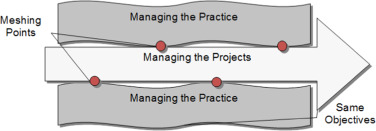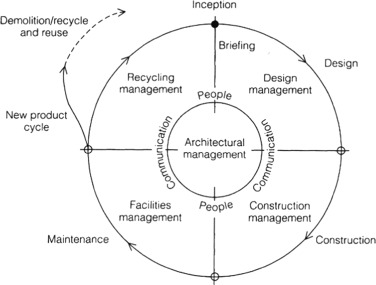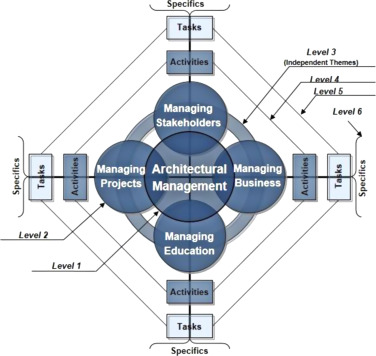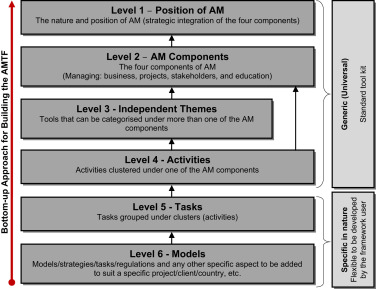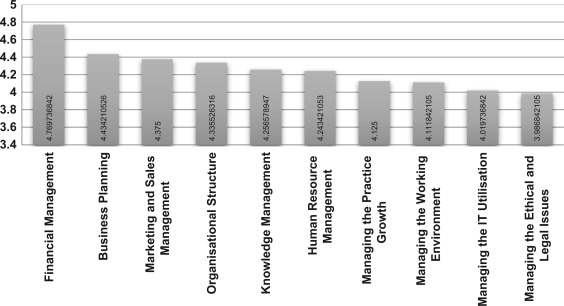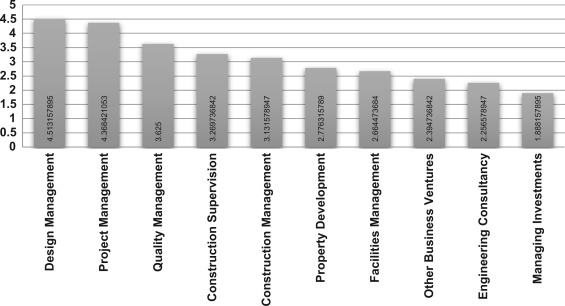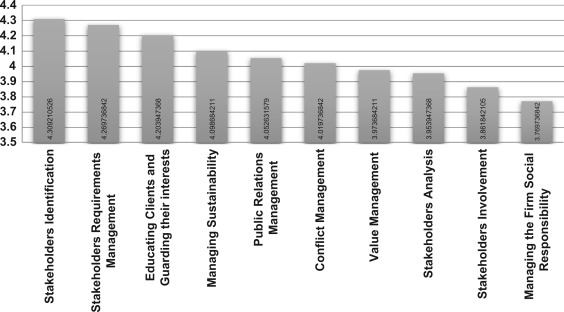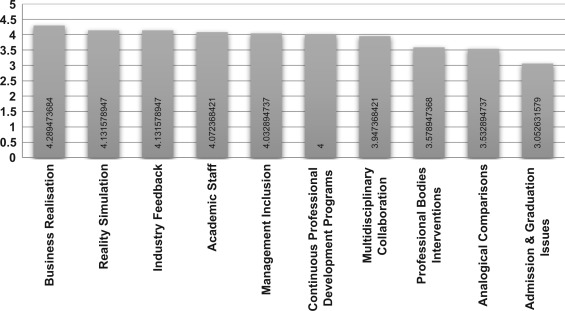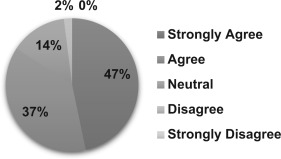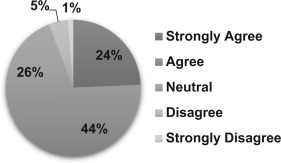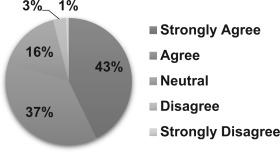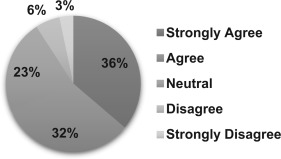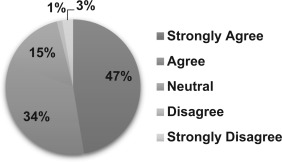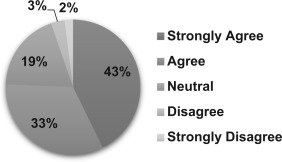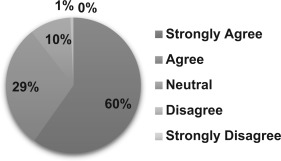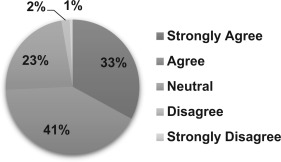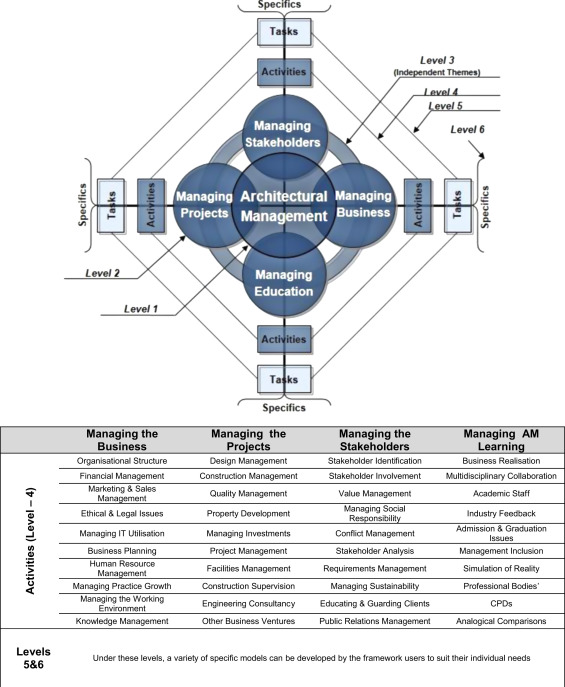Abstract
This research aimed to develop a unique framework to help architects understand and apply architectural management (AM) in their practices. A comprehensive literature review identified several components belonging to different specialist fields. A pragmatic methodology for developing the framework was adopted by combining the methodology of Japareen for building conceptual frameworks with the Concept Mapping and Qualitative Met-Synthesis techniques. The resulting framework underwent a series of testing stages aimed at refining the framework further. The testing process targeted two groups (researchers and professionals) by adopting a mixed method approach, which included a facilitated workshop, interviews, and a questionnaire survey. The feedback from the testing phase was used to create the final AM Taxonomy Framework (AMTF), and served as an original and practical guide for practitioners, further extending their understanding of AM. Further validation and refinement are planned in the long term by applying the framework to selected architectural practices.
Keywords
Architectural management ; Architectural practice ; Framework design ; Taxonomy
1. Introduction
Construction literature identifies many guiding frameworks that may inspire practitioners to achieve better practices, improve their knowledge, and effectively deploy tools and systems for various tasks, including design, project, and quality management. In relation to this, several reports suggest that architecture practitioners must improve the way with which they manage their businesses. This argument can be traced back to The Architect and His Office [Royal Institute of British Architects ( RIBA, 1962 )], which highlights the need for better management skills and knowledge among architects. This argument has been maintained over the years in the architecture management (AM) literature (e.g., Brunton et al ., 1964 ; Nicholson, 1995a ; Emmitt, 1999a ; Alharbi et al ., 2015 ). A comprehensive review of the small yet increasing volume of research in the AM field reveals that previous studies have primarily focused on the creation of a knowledge base, but not on how to bring such knowledge into practice. Although the need for improvements is acknowledged, the achievement of such improvements is not supervised by any guideline. Specifically, previous studies lack a mutual agreement on the normative focus of AM, its core components, and the intersection between these components, thereby limiting our understanding of such concept. Furthermore, previous studies have mostly failed to distinguish AM from other managerial fields (e.g., project management) and specify its requirements (see, e.g., Alharbi et al., 2015 ). Hence a clear set of guidelines for architects must be established considering that AM is a developing field and an important issue for architects working in a management-oriented construction sector.
Since its introduction over 50 years ago by Brunton et al. (1964) the concept of AM remains open to interpretation in the literature despite several studies that have articulated the importance of adopting such concept, especially by the CIB Working Group W096 Architectural Management (see Emmitt et al., 2009 ). Although CIB W096 is the only international network dedicated to examining and promoting AM, this group has yet to adopt a definitive definition of this concept; a criticism that can be made of their only book, Architectural Management: International Research & Practice ( Emmitt et al., 2009 ). For clarity, this research adopts the following original and recent definition of AM, which is grounded in empirical research:
Architectural Management (AM) is the strategic management of the architectural firm that assures the effective integration between managing the business aspects of the office with its individual projects in order to design and deliver the best value to all stakeholders (Alharbi, 2013 ).
However, providing a clear definition of AM is only part of a bigger challenge. The present definition does not provide the level of detail required to understand and apply AM into practice. Therefore, the current research aims to develop a practical and generic framework that can help architects apply AM in their professional practices to suit their specific contexts and requirements. A pragmatic framework can help architecture practitioners understand and manage their businesses effectively, thereby improving the services that they can provide to their clients.
2. Literature review
This literature review reveals the lack of a structured guideline for transferring AM from theory to practice. Miles and Huberman (1994) defined a “framework” as any visual/written product for explaining factors, concepts, variables, and their presumed relationships. Based on this definition, three guiding frameworks have been identified at the abstract level. The definition of AM proposed by Brunton et al. (1964) , which illustrates the relationship between the two components of AM (i.e., “Managing the Business” and “Managing Projects”) is generally considered the first taxonomy framework (Figure 1 ).
Architectural Management falls into two distinct parts, office or practice management and project management. The former provides an overall framework within which many individual projects will be commenced, managed and completed. In principle, both parts have the same objectives but the techniques vary and mesh only at certain points (Brunton et al., 1964 , p. 9).
|
|
|
Figure 1. Graphical interpretation of the definition of Brunton et al. (1964) . |
However, the framework proposed by Brunton et al. did not illustrate the sub-components and deliverables of AM; their work deliberately focused on only a single component of AM, which is Managing the Business. Based on Brunton et al., Emmitt, 1999a ; Emmitt, 2007 provided the first practical written guideline for applying AM in practice. Emmitt (1999a) offered another visual framework, which illustrated the central position of AM within the project lifecycle (Figure 2 ). This framework was conceived at a time when the components of AM were not clearly agreed upon. Moreover, the data for managerial tasks and the needs of architects used in this framework are now considered outdated. However, Emmitt distinguished and highlighted a principal difference between AM and design management, in which the former is a more comprehensive field of knowledge and practice that encompasses the issues of design process, architectural firm, architectural education, and architecture profession as a whole (Emmitt, 1999a ; Emmitt, 1999b ). Accordingly, design management has become an integral part of AM.
|
|
|
Figure 2. Position of AM within the project lifecycle (Emmitt, 1999a ). |
The categories identified by Brunton et al. (1964) are not stated clearly within the literature, which has been produced under the umbrella of CIB W096. Although these studies are primarily focused on the functions associated with design management activities or architectural value, only few have discussed other managerial activities (Emmitt et al., 2009 ) as admitted by some CIB W096 researchers (e.g., Den Otter, 2009 ; Prins, 2009 ). A similar observation can be made about the literature outside the CIB W096 domain (e.g., Green, 2001 ; Piven and Perkins, 2003 ; Littlefield, 2005 ), which focuses on the issues typically managed within the firm, such as strategic planning, business modelling, marketing, human resources, IT utilization and other business functions, while largely ignoring the other component of AM, namely, Managing the Projects. Therefore, the two components of AM identified by Brunton et al. no longer sufficiently encapsulate the relatively new issues that are being debated upon within the CIB W096 domain, such as education, sustainability, stakeholders, and regulations.
3. Method
Many studies have investigated how frameworks can be established, but this issue lacks a practical guideline. Previous framework design processes are based on the Concept Mapping method of Novak and Gowin (1984) . This method involves two stages: (1) identifying concepts and (2) determining the relationships between them. Based on this theorization, Jabareen (2009) suggested a more pragmatic process for building conceptual frameworks using the methodology of grounded theory rather than describing the data and the targeted phenomenon. This methodology focuses on understanding rather than prediction, and involves eight sequenced phases, including mapping the selected data sources, extensively reading and categorizing the selected data, identifying and naming the concepts, deconstructing and categorizing the concepts, integrating the concepts, synthesis and re-synthesis, validating the conceptual framework, and rethinking the conceptual framework.
AM is composed of several components that belong to different management specialities (e.g., design, business, project, construction, and quality management). Hence, understanding such phenomenon requires a multidisciplinary approach, such as combining the methodology of Jabareen with the Concept Mapping technique during the generation of the AM Taxonomy Framework (AMTF). The AMTF comprises three main sequential stages. First, a systematic design procedure for composing the framework is performed and a list of standards is produced. Second, a comprehensive literature review is conducted to extract the components and sub-components of AM. Third, the extracted data are analyzed and synthesized through the qualitative met-synthesis approach.
The theoretical sources of data include the following:
- All materials that directly target AM and are published from 1964 (initial introduction of the term) to present (i.e., Brunton et al ., 1964 ; Nicholson, 1995a ; Emmitt, 1999a ; Emmitt, 1999b );
- All accessible publications of the CIB W096 AM Working Group from its formative conference in 1992 and establishment in 1993 to present (i.e., Nicholson, 1992 ; Nicholson, 1994 ; Nicholson, 1995a ; Nicholson, 1995b ; Emmitt and Prins, 2005 ; Emmitt et al ., 2009 ; Tzeng et al ., 2009 ; CIB W096, 2010 ; Den Otter et al ., 2011 );
- All publications that cover some aspects of AM (e.g., Green, 2001 ; Piven and Perkins, 2003 ; Littlefield, 2005 ; Emmitt, 2007 ; Winkler and Chiumento, 2009 ; Liebing, 2010 ; Imrie and Street, 2011 ) and
- The managerial content of five popular UK and global architectural journals (i.e., The Architect’s Journal , The RIBA Journal , The Architectural Record , Architecture , and The Architect ). The categorical and content analyses of these journals are conducted from the establishment of each journal until 2014.
Qualitative met-synthesis was performed because this enabled researchers to integrate and contextualize the findings of different but related studies, with the aim of interpreting rather than aggregating these studies to create new knowledge (Noblit and Hare, 1988 ; Jensen and Allen, 1996 ; Gough and Elbourne, 2002 ). Through this procedure, the findings of previous studies addressing similar theoretical issues were categorized into six groups, namely, Nature and position of AM within architectural practice, Managing the business side of the profession, Managing the individual projects (business portfolio), Managing stakeholders, Managing AM education, and Independent themes.
4. AMFT
The development of the (generic) framework involved a bottom-up approach to group tasks/activities, resulting in a framework hierarchy with six levels (Figure 3 ). These levels included tasks that serve as the basis of development (Level 5), the clustering of these tasks according to their combined themes (Level 4 activities), the combining theme (Level 2: AM components), several independent themes that can be applied to more than one category (and can be used as tools for deploying and enhancing the application of AM Level 3), and the intersection between these themes and the position of AM in the whole process (Level 1). The lowest levels (5 and 6) were left open and flexible to allow the addition of specific models or tasks to suit specific contexts (e.g., country, client, and project type).
- Level 1—Nature and position of AM: If the goal of the practitioner is the effective application of this concept, then the nature of AM must be at the strategic position of the practice. Value is harvested at the level in which the competitive advantage is created ( Rumelt, 1991 ). This position means that AM strategically integrates all the other five themes to achieve competitiveness. Strategic integration means that all of the Level 4 activities and Level 5 tasks must be managed in relation to the framework as a whole. In doing so, AM is given the central position within the framework (Figure 4 ).
|
|
|
Figure 4. The AMTF. |
- Level 2—AM Components:
- Managing the business side of the profession: Managing the office is the first component of AM, and it includes realizing and managing all functions that are performed or must be performed within the architectural office (i.e., the internal environment) to achieve competitiveness. During the qualitative met-synthesis, 10 managerial tasks (Level 4 at the AMTF) were classified under this category, namely, Organizational Structure, Business Planning, Financial Management, Human Resource Management, Marketing and Sales Management, Managing Practice Growth, Managing Ethical and Legal Issues, Managing the Working Environment, Managing IT Utilization, and Knowledge Management.
- Managing the individual projects: Managing the individual projects (i.e., managing the portfolio) is the second component of AM, and includes managing all other functions associated with the architectural profession beyond the architectural design, and engaging the market for other business opportunities. During the qualitative met-synthesis, 10 managerial tasks (Level 4) were classified under this category, namely, Design Management, Project Management, Construction Management, Facilities Management, Quality Management, Construction Supervision, Property Development, Engineering Consultancy, Managing Investments, and Other Business Ventures.
- Managing AM education: Managing AM education is the third component of AM, and includes the different strategies/actions that must be considered to introduce and enhance the concept of AM among architecture students and practitioners. The implementation of AMTF and its related activities/tasks requires the embedding of such framework in the basic education and continuing professional developmental training (CPD) of architects. During the qualitative met-synthesis, 10 managerial tasks (Level 4) were classified under this category, namely, Business Realization, Management Inclusion, Multidisciplinary Collaboration, Reality Simulation, Academic Staff, Interventions of Professional Bodies, Industry Feedback, Continuing Professional Development Programs, Admission and Graduation Issues, and Analogical Comparisons “with Other Industries and Markets.”
- Managing stakeholders: Managing stakeholders is the fourth component of AM, and includes all activities and tasks for managing different types of stakeholders as well as for designing and delivering the best value for them. During the qualitative met-synthesis, 10 managerial tasks (Level 4 at the AMTF) were classified under this category, namely, Stakeholder Identification, Stakeholder Analysis, Stakeholder Involvement, Management of Requirements, Value Management, Managing Sustainability, Managing the Social Responsibility of the Firm, Educating Clients and Guarding their Interests, Conflict Management, and Public Relations Management.
- Level 3: Independent themes: Several functions can be applied to more than one component of AM. These themes can be used as a set of tools to help improve the deployment of AM in practice. This category is flexible (hence, not restricted) to include any future tool that can be utilized by anyone who chooses to adopt the AM framework. Examples of these functions (Level 4) include Leadership, Culture, Creativity, Communication, Collaboration, Innovation, Lean Thinking, Value Streams, Continuous Improvement, Performance Management, and Benchmarking.
|
|
|
Figure 3. The AMTF building philosophy. |
5. Validating the AMTF
During the development of the AMTF, several revisions were made based on informal piloting sessions with architects. These informal feedback mechanisms were instrumental in verifying the consistency, logic, and integrity of the AMTF in terms of its methodology and outcome. The AMTF was then prepared for testing its alignment with actual industry conditions.
The optimum way to examine the validity of the AMTF was to apply this framework in real scenarios (i.e., an architectural practice) and observe its effectiveness. Hence, performing this test would require permission from the owners of architectural practices. Understandably, the initial enquiries to architectural practitioners approached by the authors were met with reluctance and cautious response: some business owners claimed that the untested framework posed a huge risk to their businesses. The amount of time and resources required to implement the framework posed another challenge, which exceeded the scope of this research. With limited resources and the perception among practitioners that the AMTF is a risky experiment, a preliminary examination and validation of the framework was performed by “applying” the framework in academic and professional discussion environments. The AMTF was coded and tested in a series of stages using different methods. The outcome of each stage would add certain developments (refinements) to the newly proposed framework before conducting the next testing stage. These stages are described below.
- First Testing Session (AMTF-1): This stage targeted the academic AM community represented by the members and affiliates of the CIB W096. A facilitated workshop was conducted at a CIBW096 International Conference in Vienna, Austria. A total of 29 individuals from five continents (i.e., Asia, Australia, Europe, North America, and South America) participated in the workshop.
- Second Testing Session (AMTF-2): This stage targeted the senior architectural researchers outside the CIB W096 community. Given the qualitative nature of this stage, the number of interviews was determined by reaching a theoretical saturation ( Miles and Huberman, 1994 ; Patton, 2002 ). This was achieved by conducting eight semi-structured interviews with senior architectural researchers in the management field coming from countries not covered by previous CIB W096 conferences (i.e., Middle East and North Africa).
The first two testing stages (AMTF-1 and 2) were purely qualitative and targeted academic architectural researchers within and outside the CIB W096 AM community. Academic researchers were targeted to test the practicality, clarity, and appropriateness of the AMTF. The objective of these two stages was to discuss and examine the suitability of the AMTF (from different international perspectives) as a guideline for transferring AM from theory into practice, through a thorough examination of its position, components, and hierarchies.
- Third Testing Session (AMTF-3): This stage was mainly quantitative and examined the professional opinions of architecture practitioners. This stage aimed to test the practicality, clarity, and appropriateness of the AMTF by obtaining and analyzing data on the opinions of its potential users. The findings from the earlier testing stages revealed that newly graduated or relatively inexperienced architects might not recognize the concept of AM because the adoption and application of AM in practice required leadership and experience ( Nicholson, 1995a ; Emmitt, 1999a ). Accordingly, this stage targeted the principals of architectural practices registered with RIBA in the UK. A questionnaire was chosen as the most appropriate data collection instrument because this testing session was associated with rating judgements (Oppenheim, 2000 ). All 2881 RIBA-registered practices in the UK were given the questionnaire. Out of 2881 principals, 153 returned completed questionnaires, yielding a response rate of 5.3%. Given the low response rate, the analyzed data could not represent the entire population of architectural principals in the UK. However, the findings could still add insights into the process of testing and refining the AMTF.
6. Results
Two types of researchers (CIB W096 and architectural researchers) discussed 23 issues during the first two qualitative testing stages. The majority of these issues required clarification rather than the defence of the framework. Four common issues were found in both groups, namely, the suitability of the framework for practitioners, the name of the “Education” component, the relevance of the AMTF to the project lifecycle, and the required degree of experience to use and apply this framework. These issues revealed the need to further describe Level 4 of the framework components in order to avoid confusion. Generally, the two testing groups appreciated the framework generation idea and the applied methodology. The participants also praised the hierarchy of the framework and agreed that the “Managing Education” component should be replaced by “Managing (AM) Learning” because “learning” is more applicable to architectural education and CPD. The participants also felt that both components of AM should be better managed to enhance intellectual capital. Both researcher groups were in favor of giving higher importance to the Managing the Projects component, followed by Managing the Business , Managing the Stakeholders , and Managing Learning .
Despite the agreements shown above, the rankings given by the architectural principals on these components revealed contrasting results. In AMTF-3, a list of 40 managerial tasks (Level 4 of the AMTF) was grouped under four categories, namely, Managing the Business, Managing the Projects, Managing the Stakeholders , and Managing AM Learning . The participants were asked to rank the degree of importance of each item to their professional practice. To analyze the collected data statistically, a five-point scale (Table 1 ) was used to establish a quantitative measure of the importance index.
| Importance scale | |||||
|---|---|---|---|---|---|
| Option | Extremely important | Important | Moderately important | Slightly important | Not at all important |
| Option index | 1 | 2 | 3 | 4 | 5 |
| Weight | 5 | 4 | 3 | 2 | 1 |
The following relative index formula (1) (Kirk, 2008 ; Healy, 2011 ) was used to evaluate the rankings:
|
|
( 1) |
where
- i represents the response index (option index) as shown in Table 1 ,
- Wi represents the assigned weight to option i as shown in Table 1 , and
- Xi represents the number of respondents who have selected option i .
The importance index of each item was calculated separately and ranked accordingly using the above equation. The mean value of each category “component of AMTF” was then calculated and compared against that of other categories.
Under the Managing the Business component, the surveyed professionals ranked Financial Management as the most important function for their architectural firms (importance index: 4.77/5), followed by Business Planning (4.43), Marketing and Sales Management (4.38), Organizational Structure (4.34), Knowledge Management (4.26), Human Resource Management (4.24), Managing Practice Growth (4.13), Managing the Working Environment (4.11), Managing IT Utilization (4.02), and Managing Ethical and Legal Issues (3.99). All these managerial activities were ranked above 4 (out of 5) on the importance index; hence, these were considered essential parts of the AMTF. The relative importance indexes for these items are shown in Figure 5 .
|
|
|
Figure 5. Managing the Business components—importance ranking. |
Under the Managing the Projects component, the surveyed professionals ranked Design Management and Project Management as the two most important functions for their architectural firms (4.51 and 4.35, respectively). These activities were followed by Quality Management (3.63), Construction Supervision (3.27), Construction Management (3.13), Property Development (2.78), Facilities Management (2.66), Other Business Ventures (2.39), Engineering Consultancy (2.26), and Managing Investments (1.89). The degrees of importance given to these activities were clearly different from those given to the activities in the first component. The relative importance indexes for these items are shown in Figure 6 .
|
|
|
Figure 6. Managing the Projects components—importance ranking. |
Under the Managing the Stakeholders component, the surveyed professionals ranked Stakeholder Identification and Management of Requirements as the two most important functions for their architectural firms (4.31 and 4.23, respectively). These activities were followed by Educating Clients and Guarding their Interests (4.20), Managing Sustainability (4.10), Public Relations Management (4.05), Conflict Management (4.02), Value Management (3.97), Stakeholder Analysis (3.95), Stakeholder Involvement (3.86), and Managing the Social Responsibility of the Firm (3.77). Despite the fact that these managerial functions have varying degrees of importance, they still maintain a high degree of importance. The relative importance indexes for these items are shown in Figure 7 .
|
|
|
Figure 7. Managing the Stakeholders components—importance ranking. |
Under the Managing the AM Learning component, the surveyed professionals ranked the elements in the following order: Business Realization (4.29), Reality Simulation (4.13), Industry Feedback (4.13), Academic Staff (4.07), Management Inclusion (4.03), Continuous Professional Development Programs (4.00), Multidisciplinary Collaboration (3.95), Interventions of Professional Bodies (3.58), Analogical Comparisons (3.53), and Admission and Graduation Issues (3.05). All of the proposed strategies had relatively high degrees of importance ranging between 3.5 and 4.29, except for Admission and Graduation (3.05). The relative importance indexes for these items are shown in Figure 8 .
|
|
|
Figure 8. Managing learning components—importance ranking. |
The importance of all AM components was ranked by calculating the mean importance indexes of the four components of AM using Eq. (2) . The results are shown in Figure 9 .
|
|
( 2) |
(adopted from Kirk, 2008 ; Healey, 2011) where:
- x represents the importance index of each managerial activity in its associated component of the AMTF, and
- n represents the number of managerial activities under each component.
|
|
|
Figure 9. Mean importance of the four main components of AM. |
Figure 9 confirms the high and relatively similar degrees of importance of the four components of AM. Managing the Business , highlighted by Brunton et al. (1964) and Emmitt (1999a) , was the most important component of the AMTF (4.27), followed by Managing the Stakeholder (4.05), Managing Learning (3.88), and Managing the Projects (3.09). The results for the Stakeholders and Learning components confirmed that recent AM publications shifted their focus toward other components that had to be realized and captured within AM.
Similarly, in the questionnaire survey, the respondents were asked to state their degree of agreement with some issues associated with the nature and application of AM. These issues were provided in the form of textual statements. The respondents were asked to indicate their degree of agreement with each issue on a five-point scale (5=strongly agree and 1=strongly disagree). The majority of the surveyed principals (84%) expressed agreement that the decision to adopt AM should be taken at the strategic level of the firm (Figure 10 ). Similarly, 67.3% confirmed the view of Emmitt (1999a) , who suggested that adopting AM would improve the competitiveness of its users (Figure 11 ) and was associated with the continuous improvement of the architectural office (79.8%, Figure 12 ). Around 67.9% of the respondents believed that AM can be utilized by any architectural firm regardless of size (Figure 13 ). This result is in accordance with those of Emmitt (1999a) and Littlefield (2005) , who suggested that despite the size of their organizations (measured by the number of employees), architects could adopt and apply AM successfully in their practices. The majority of the surveyed principals agreed that the successful application of AM in practice would require an effective leadership (81.1%, Figure 14 ), strong organizational culture (75.8%, Figure 15 ), effective communication (89.5%, Figure 16 ), and effective collaboration (74.5%, Figure 17 ). These results confirm the findings from the qualitative testing stages of the framework and are consistent with those reported by Emmitt, 1999a ; Emmitt, 1999b .
|
|
|
Figure 10. AM and the strategic management level. |
|
|
|
Figure 11. The role of AM in gaining competitiveness. |
|
|
|
Figure 12. The relationship among AM, performance management, and continuous improvement. |
|
|
|
Figure 13. AM application and organization size. |
|
|
|
Figure 14. The relationship between AM and effective leadership. |
|
|
|
Figure 15. The relationship between AM and organizational culture. |
|
|
|
Figure 16. Effective communication as a requirement for AM application. |
|
|
|
Figure 17. Effective collaboration as a requirement for AM application. |
The overall feedback from the three testing sessions was mostly positive, with only few corrective comments from the participants that were subsequently implemented. Based on this feedback, a table was added to the graphical version of the framework, thus improving clarity by illustrating the activities subsumed under Level 4. The final version of the AMTF is illustrated in Figure 18 .
|
|
|
Figure 18. Detailed AMTF matrix. |
7. Discussion
One of the running themes in this research was to encourage architecture practitioners to adopt AM to sustain competitiveness in a dynamic market. To date, no previous study has discussed details on how architecture practitioners can adopt AM. This research proposed that a successful adoption of AM would require a full understanding of the meaning, components, and requirements of such concept. A polished final framework could thus help practitioners develop their understanding of AM according to their own unique contexts. The following factors are also required for the successful adoption of AM, and can be explored in future research
- Ensuring the full commitment of staff and team members toward mutual goals and shared values;
- Effectively utilizing managerial and technological advances and innovations;
- Ensuring the appropriateness of staff training and knowledge sharing in promoting business development;
- Establishing and managing effective communication channels with different stakeholders;
- Continuous collaboration with professional bodies and architectural educators; and
- Developing practical and specific strategies to suit the specific nature and resources of each individual practice.
These factors must be considered at the strategic level of firms and require an architectural manager (or design manager) who is responsible for planning, monitoring, and developing the application of AM. Further research must also be conducted to establish the core competences of an architectural manager who is working in an architectural office. Specifically, ethnographic studies and/or action research must be conducted in architectural offices to determine the benefits of employing an architectural manager. Applying the AMTF in actual practice opens up opportunities to conduct further (applied) research that aimed to examine how the AMTF can actually help architects apply AM and better manage its four components (business, projects, stakeholders, and learning).
8. Conclusion
Similar to other research, this project has several limitations. The AMTF framework was developed to facilitate better understanding of AM among practitioners and to provide them a mechanism for transferring this concept from theory into practice. However, this framework is not a direct business protocol for applying AM. Such framework only comprises two parts, namely, generic and specific: the former helps users realize the components of AM and their inter-related relationships, whereas the latter provides enough flexibility for the users and their needs as bases for developing further practical applications of AM in their respective professional practices. Given the subjective nature of the interpretive stance in this study, the findings may be subject to other interpretations, which can limit the generalizability of the findings (Bryman, 2007 ; Bryman, 2008 ). Moreover, the framework has only been tested quantitatively by examining the views of architecture practitioners in the UK. Nevertheless, the proposed framework can be applied beyond this geographical limit because of its deliberately generic content. In this light, further research must test the application of the AMTF in other countries to expand the focus and the geographical boundaries of this research. Although this research focuses on architectural practices, the findings can also be used by other design-oriented professionals, such as architectural technologists, technicians, and building surveyors.
Despite these limitations, the proposed framework provides a unique contribution to the field of AM by providing the first pragmatic tool, which can be used by architecture practitioners in their respective practices. This research has also extended the theoretical understanding of AM, thus adding to the current knowledge pool discussed in the AM literature. Although the AMTF has yet to be applied to architectural practice, the feedback from the testing stages is extremely positive, with architects welcoming an innovative framework that they can use in their practices. Such feedback entails the future application of the AMTF, but a challenge remains in identifying architecture practitioners who are willing to take the necessary practical steps to apply such framework. This challenge should be addressed in future research.
References
- Alharbi, 2013 M.A.S. Alharbi; Architectural Management: A Strategic Framework to Achieve Competitiveness; Unpublished Ph.D. Thesis Loughborough University, UK (2013)
- Alharbi et al., 2015 M.A.S. Alharbi, S. Emmitt, P. Demian; What is architectural management? Towards a pragmatic definition; J. Eng. Constr. Archit. Manage., 22 (2) (2015), pp. 151–168
- Brunton et al., 1964 J. Brunton, R. Hellard, H. Boobyer; Management Applied to Architectural Practice; George Godwin, London (1964)
- Bryman, 2007 A. Bryman; The research question in social research: what is its role?; Int. J. Soc. Res. Methodol., 10 (1) (2007), pp. 5–20
- Bryman, 2008 A. Bryman; Social Research Methods; (third ed.)Oxford University Press, Oxford (2008)
- CIB W096, 2010 CIB W096 2010. Proceedings of the CIB-W096 special track: better building through architectural management: methods, tools and techniques. In: The 18th CIB World Building Congress, CIB Publication 348, The Lowry Salford Quays, United Kingdom, 10–13 May 2010.
- Den Otter, 2009 A. Den Otter; Value and challenge of Virtual collaboration and communication in architectural design; C. Tzeng, S. Emmitt, M. Prins (Eds.), Future Trends in Architectural Management—The International Symposium CIB-W096-2009 Taiwan, 2–4 November 2009, vol. 324, Cheng Kung University, CIB Publication, Taiwan (2009) pp (v)
- Den Otter et al., 2011 Den Otter, A.F. H.J., Emmitt, S., Achammer, C. (Eds.). Architectural management in the digital Arena. In: Proceedings of the CIB-W096 Conference, 13–15 October 2011. Vienna University of Technology: Austria, Publisher: University Press—Eindhoven University of Technology (TU/e), Eindhoven
- Emmitt, 1999a S. Emmitt; Architectural Management in Practice: A Competitive Approach; Pearson Education, Harlow (1999)
- Emmitt, 1999b S. Emmitt; Architectural management—an evolving field; J. Eng. Constr. Archit. Manage., 6 (2) (1999), pp. 188–196
- Emmitt, 2007 S. Emmitt; Design Management for Architects, Blackwell Publishing, Oxford (2007)
- Emmitt and Prins, 2005 Emmitt, S., Prins, M. (Eds.). Designing value: new directions in architectural management. In: Proceedings of the CIB-W096-2005 Special Meeting, 2–4 November 2005, 307. Technical University of Denmark: Denmark, CIB Publication
- Emmitt et al., 2009 Emmitt, S., Prins, M., Den Otter, A. (Eds.). 2009. Architectural Management—International Research and Practice. John Wiley & Sons, Chichester
- Gough and Elbourne, 2002 D. Gough, D. Elbourne; Systematic research synthesis to inform policy, practice and democratic debate; Soc. Policy Soc., 1 (1-12) (2002), p. p
- Green, 2001 R. Green; The Architect’s Guide to Running a Job; The Architectural Press, Oxford (2001)
- Healy, 2011 J.F. Healy; Statistics: A Tool for Social Research (Ninth ed.), Wadsworth, Belmont (2011)
- Imrie and Street, 2011 R. Imrie, E. Street; Architectural Design and Regulations; Wiley-Blackwell, Oxford (2011)
- Jabareen, 2009 Y. Jabareen; Building conceptual framework: philosophy, definitions and procedure; Int. J. Qual. Methods, 8 (4) (2009), pp. 49–62
- Jensen and Allen, 1996 L.A. Jensen, M.N. Allen; Meta-synthesis of qualitative findings; Qual. Health Res., 6 (4) (1996), pp. 553–560
- Kirk, 2008 R.E. Kirk; Statistics: An Introduction; (fifth ed.)Wadsworth, Belmont (2008)
- Liebing, 2010 R.W. Liebing; The Other Architecture: Tasks of Practice Beyond Design; Springer, London (2010)
- Littlefield, 2005 D. Littlefield; The Architect’s Guide to Running a Practice; Architectural Press, London (2005)
- Miles and Huberman, 1994 M.B. Miles, A.M. Huberman; Qualitative Data Analysis: An Expanded Source Book; (second ed.)Sage Publications, London (1994)
- Nicholson, 1994 M.P. Nicholson; A handy future for smart architects; P. Nicholson (Ed.), The International Journal of Architectural Management – Practice and Research – Proceedings of a Meeting of CIB W096 Architectural Management, 17–18 September 1994, 170, The University of Nottingham: Nottingham, CIB Publication (1994), p. 118-127
- Nicholson, 1995a M.P. Nicholson; Architectural Management: from Higgin to Latham; Unpublished Ph.D. Thesis University of Nottingham, Nottingham (1995)
- Nicholson, 1995b M.P. Nicholson; Architectural management—towards a definition; P. Nicholson (Ed.), The International Journal of Architectural Management – Practice and Research – Proceedings of a Joint Meeting of CIB W096 Architectural Management & W82 Future Studies, 12–13 May 1995, 9, Amsterdam, CIB Publication (1995), pp. 1–10
- Nicholson, 1992 M.P. Nicholson (Ed.), Architectural Management, E & F.N. Spon, London (1992)
- Noblit and Hare, 1988 G.W. Noblit, D. Hare; Meta-ethnography: Synthesizing Qualitative Studies; Sage Publications, London (1988)
- Novak and Gowin, 1984 J.D. Novak, D.B. Gowin; Learning How to Learn; Cambridge University Press, Cambridge (1984)
- Oppenheim, 2000 A.N. Oppenheim; Questionnaire Design, Interviewing and Attitude Measurement; (second ed.)Continuum, London (2000)
- Patton, 2002 M.Q. Patton; Qualitative Research and Evaluation Methods (third ed.), Sage Publications, London (2002)
- Piven and Perkins, 2003 P. Piven, B. Perkins; Architect’s Essentials of Starting a Design Firm; John Wiley & Sons Inc, New Jersey (2003)
- Prins, 2009 M. Prins; Architectural value; S. Emmitt, M. Prins, A. Otter (Eds.), Architectural Management—International Research and Practice, 3-18, John Wiley & Sons, Chichester (2009), p. p
- RIBA, 1962 RIBA 1962. The Architect and His Office, RIBA, London.
- Rumelt, 1991 R. Rumelt; How much does industry matter?; Strategic Manage. J., 12 (1991), pp. 167–185
- Tzeng et al., 2009 Future trends in architectural management; C. Tzeng, S. Emmitt, M. Prins (Eds.), the International Symposium CIB-W096-2009 Taiwan, 2–4 November 2009, Cheng Kung University: Taiwan, CIB Publication (2009), p. 324
- Winkler and Chiumento, 2009 G. Winkler, G. Chiumento; Construction Administration for Architects; McGraw-Hill, New York (2009)
Document information
Published on 12/05/17
Submitted on 12/05/17
Licence: Other
Share this document
Keywords
claim authorship
Are you one of the authors of this document?
